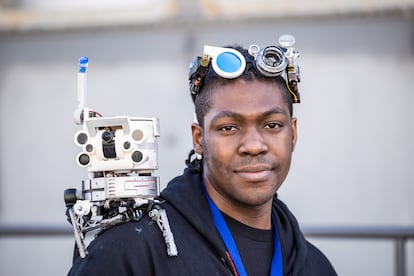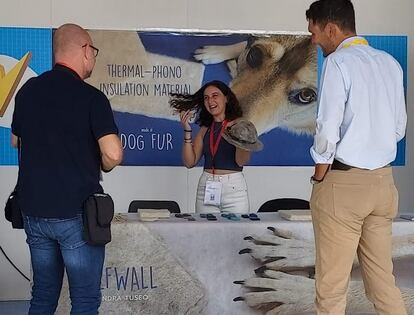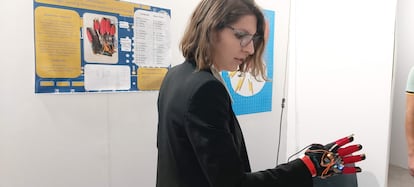Europe’s biggest tech expo showcases dog-hair insulation and a flying bike
At Maker Faire Rome, the fable of the blind men and the elephant illustrates how diverse solutions are needed to solve complex problems

“The world is not binary. You can be a generalist or a specialist, but you need both types of people to solve the complex problems of today,” says Kenneth Mikkelsen, founder of the Future Shifts consulting firm and member of the Copenhagen Institute for Futures Studies in Denmark. Mikkelsen aptly summed up the spirit of Maker Faire 2022, the tenth edition of Europe’s largest technology exhibition. In early October, Rome hosted 480 organizations, creators, inventors, companies of all sizes, start-ups, investors and 45,000 visitors to showcase the future of European innovation. Except for the nuclear fusion technology presented by Eni SpA, an Italian energy company, no groundbreaking innovations were on display at Maker Faire. Instead, visitors saw many individual solutions that taken together, can meet the challenges of tomorrow.
Mikkelsen uses the fable of the six blind men and the elephant to explain the future of technological development. When they touch and feel the different parts of the elephant, they each imagine a different reality. The one feeling the tail imagines a rope, while the one touching the trunk imagines a snake, and so on. Each individual has a partial and therefore inaccurate perception of reality. Mikkelsen says the blindfolds must be removed so we can perceive the full reality, and develop individual solutions to tackle complex problems. “There are silos in our minds that exclude many people. We need to connect people, work to change existing systems, educate ourselves for the future, understand what we are today and what we want to become. Otherwise, there will be no innovation.”

Large companies and organizations always have something to show at Maker Faire, but their well-known products stand side-by-side with smaller innovations that offer often surprising approaches and technologies. Below are some examples of these European innovators and their unique creations.

Dog-hair insulation
Alessandra Tuseo is only 24 years old. She wrote her university thesis on thermal and acoustic insulation materials for buildings. Annoyed by all the hair shed by her dog, Tuseo says she applied her academic expertise to the problem and discovered a material that performs better than wool fiber. “It can also be used to make clothing,” she says with a smile as she shows us a hat made from her pet’s hair. While she’s still looking for interested investors, her idea is just one example of all the little tiles that make up the mosaic of European innovation. Dozens of entrepreneurs like Tuseo exhibited their products and ideas at Maker Faire Rome – companies that recycle photovoltaic panels, use solar power to break down plastics, build a greenhouse that mechanically adapts to the weather, and manufacture a small portable sphere that analyzes the purity of drinking water.

A robot waiter that reads the news
Automated solutions for routine and complex jobs are always on display at Europe’s largest innovation exhibition. The Brillo bartending robot can do a few other things besides making and serving drinks. While it’s busy preparing an order, it asks the customer, “Would you like to hear the latest news?” Brillo’s access to online information and programmed artificial intelligence enables it to interact with customers. Another inventor, Andrea Grillo, shows off Isaac, a robot for search and rescue operations. “The innovative modular design enables it to get larger or smaller depending on the task at hand,” said the young entrepreneur. All kinds of robots are showing off their skills at Maker Faire – some are sophisticated humanoids and others are simple, automated machines. Some were even built from waste materials. One can fry food, serve up a grease-free product, and then filter the leftover cooking oil. Gianluca Patrassi, an engineer with Arduino (an Italian hardware and software company), says the automated fryer was created by participants in the company’s open-source project using materials and technologies commonly available in European high schools.

Typing without a keyboard
Michaela Gallucci is a scientist at Sanofi Genzyme who noticed how typing on a keyboard can be difficult for people with disabling injuries or conditions. So she invented Finger Tracking, a glove designed to completely replace a keyboard. “Each finger and hand movement transmits signals via Bluetooth (wireless transmission) that are associated with a letter or character,” said Gallucci. This enables the hand joints to write, draw, execute commands, maneuver robots, play games and help the disabled with other functions.

Object copiers
Material science technologies and 3D printers are everywhere at Maker Faire. They offer solutions for everything, like Wasp’s cement printer for construction applications to small component and custom-made surgical and orthopedic equipment manufacturing. “If you can imagine it, we can make it,” say the people at 3D Italy’s exhibit booth. Some of the more sophisticated reproduction technologies can cost up to $2,000. They’re not for “printing” plates and cups at home, but are capable of manufacturing special, custom-made components for various industries such as personalized prosthetic devices. It’s a technology that will be essential for space exploration, since there’s no delivery service for spare parts or quick trips back to Earth for repairs.
Facial recognition
Many artificial intelligence applications are on exhibit at Maker Faire, such as the Digi-Key device demonstrated by Jorvon Moss. The young man from Los Angeles puts a portable facial recognition device on his shoulder that can be easily transported to wherever it is needed. “You can use it for surveillance or whatever,” he says, perhaps unaware of the European regulations restricting “whatever” applications of facial recognition. Moss is wearing special adaptive glasses that enhance the operator’s vision in various environments, providing both precision and protection. By now, the use of image-based artificial intelligence is common in many fields like medical diagnosis. But one Maker Faire exhibitor was presenting a unique solution for identifying school bullying instances using cameras and software that recognized certain expressions on students’ faces typical of bullying behavior.
Recycling
Waste recycling technology is a booming field in Europe. Matthias Mayer, who works for Ifixit, says that repair is fundamental to technological innovation. “It has to be easy,” he says. Ifixit is an e-commerce and how-to website that sells repair parts and publishes free online repair guides for consumer electronics and gadgets. “That’s how we make money,” says Mayer, who points out that 1.5 billion mobile phones are sold every year. “There are more mobile phones than people!” he exclaims. The average American consumer owns up to 28 electronic devices, and European consumers each Sicard 22 pounds (10 kilos) of tech waste every year. Only 40% of that waste is recycled even though each device contains up to 30 scarce and valuable metals. “Repairing is both important and fun,” said Mayer. Giacomo di Muro agrees. He is exhibiting his Kinetic Driver invention, a precision screwdriver with a rotation mechanism that tightens or loosens a screw in one motion.
Art
“Technology is not just a tool – it can also be used to create art,” said an artist named Quayola, as workers set up for a performance by One Love Machine Band, a musical group of robots from Berlin that has become a regular fixture at Maker Faire. Quayola is exhibiting a video composition of ocean images and sounds created using technology. “It changes the way we look at the world. It allows us to reinterpret and explore nature and our heritage,” he said.

A flying bicycle
Maker Faire is a tech expo that welcomes everything from the latest corporate innovations to the metaverse and food printing. And there is also room for dreamers like Paz Aerospace, a small organization exhibiting a bicycle that supposedly can fly about 20 feet (seven meters). Its basic website dedicates as much space to protesting the criminalization of street graffiti as it does to FAQs about the bicycle.
Maker Faire opens its doors to all kinds of creators, innovators, companies, research organizations and inventors. There is no charge for the 500 exhibitors that cram into the gigantic old Gazometer building, a former factory near Rome’s Trastevere neighborhood. At Maker Faire, you can find everything from the latest advances in biomedicine to earrings made from recycled clocks. It’s a uniquely diverse marketplace to see where European technology might be headed. Lorenzo Tagliavanti, the president of Rome’s Chamber of Commerce and Industry, says: “Reaching this 10-year milestone with growing success is a source of pride and satisfaction for us. The event is now a recognized European reference point for the world of innovation.”
Tu suscripción se está usando en otro dispositivo
¿Quieres añadir otro usuario a tu suscripción?
Si continúas leyendo en este dispositivo, no se podrá leer en el otro.
FlechaTu suscripción se está usando en otro dispositivo y solo puedes acceder a EL PAÍS desde un dispositivo a la vez.
Si quieres compartir tu cuenta, cambia tu suscripción a la modalidad Premium, así podrás añadir otro usuario. Cada uno accederá con su propia cuenta de email, lo que os permitirá personalizar vuestra experiencia en EL PAÍS.
¿Tienes una suscripción de empresa? Accede aquí para contratar más cuentas.
En el caso de no saber quién está usando tu cuenta, te recomendamos cambiar tu contraseña aquí.
Si decides continuar compartiendo tu cuenta, este mensaje se mostrará en tu dispositivo y en el de la otra persona que está usando tu cuenta de forma indefinida, afectando a tu experiencia de lectura. Puedes consultar aquí los términos y condiciones de la suscripción digital.
More information
Últimas noticias
Most viewed
- Reinhard Genzel, Nobel laureate in physics: ‘One-minute videos will never give you the truth’
- Oona Chaplin: ‘I told James Cameron that I was living in a treehouse and starting a permaculture project with a friend’
- Pablo Escobar’s hippos: A serious environmental problem, 40 years on
- Chevy Chase, the beloved comedian who was a monster off camera: ‘Not everyone hated him, just the people who’ve worked with him’
- Why we lost the habit of sleeping in two segments and how that changed our sense of time











































